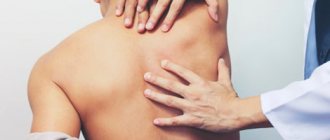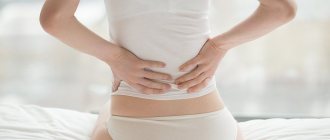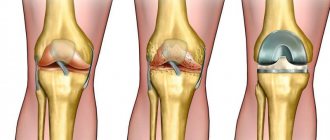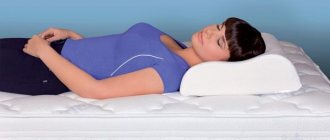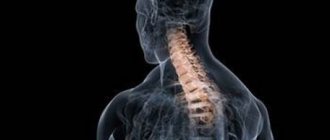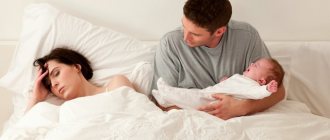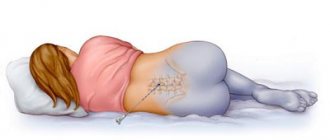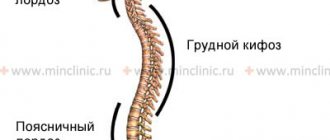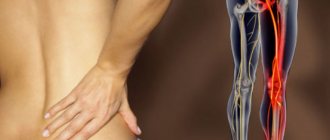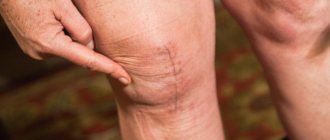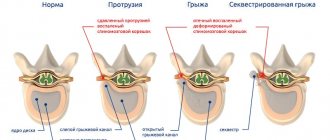Author
: Grachev Ilya Illarionovich
Editor
: Efremov Mikhail Mikhailovich
Date of publication: 30.11.2020 Date of update: 18.03.2021 All doctors of the clinic
- Severe back pain due to coronavirus and other acute respiratory viral infections
- Osteochondrosis and disc herniation
- Drug therapy
What to do if severe back pain suddenly appears, how to relieve the pain and can you do it yourself? Of course, it’s good to know how to help yourself in case of sudden severe pain, but you shouldn’t limit yourself to this: after the first emergency self-help, you should immediately consult a doctor. At the Moscow Paramita clinic they will always help you: they will determine the cause of the pain and get rid of it.
What to do for acute back pain
Back pain occurs periodically in 60-80% of the population. This is the second most common cause of temporary disability after acute respiratory viral infections. Acute back pain can begin suddenly and end just as suddenly, but it can subside slightly and become chronic. This should not be tolerated; it is better to seek medical help immediately.
Just don't panic
The appearance of severe back pain does not mean that a person cannot be helped; in most cases, all this can be successfully treated, which means there is no need to panic. But it is important to know how to help yourself and reduce pain, and then immediately consult a doctor. Contacting a specialist is necessary, since back pain is caused by many diseases and they require different approaches to treatment.
How to alleviate your condition yourself
Sometimes the pain syndrome is so severe that the person remains in the position in which the attack caught him. In this case you need:
- Lie on your back on a hard surface, or on the floor, with a blanket on it; if you can’t straighten your back, then you need to take a position that causes minimal pain.
- Ask your loved ones to give a tablet of any painkiller (Analgin, Paracetamol, Diclofenac, Ibuprofen, Nise, etc.), all of them can be bought at the pharmacy without a prescription:
- Diclofenac
is the most effective drug from the group of nonsteroidal anti-inflammatory drugs (NSAIDs); in emergency cases, it is better to use 100 mg rectal suppositories - the drug is instantly absorbed in the rectum and begins to act; contraindicated for diseases of the gastrointestinal tract (GIT), as it inhibits the effect of substances that protect the gastrointestinal mucosa from any unwanted effects; - Nise (nimesulide)
is a more modern drug from the NSAID group, has virtually no negative effect on the gastrointestinal tract, but is less effective than Diclofenac; for acute pain, you can take a 100 mg tablet; - Analgin (metamizole)
is a pain reliever; for severe pain, you can take a 500 mg tablet; Be careful: you should not take this medicine often, it gives many side effects. - Apply any pain-relieving drug for external use to the skin over the painful area: Menovazin rubbing solution, Diclofenac ointment, Pentalgin gel, Voltaren emulgel and other over-the-counter drugs:
- Menovazin
- a solution for rubbing contains two substances with a local anesthetic effect (procaine, benzocaine) + a local irritant and vasodilator menthol; the solution is applied to the skin and rubbed 2 – 3 times a day; - Diclofenac ointment and Voltaren emulgel
- contain the active substance diclofenac, which has a local anesthetic effect; apply to the skin over the painful area 2 – 3 times a day; - Pentalgin gel with the active ingredient ketoprofen from the NSAID group
- excipients have an irritating and vasodilating effect; applied to the skin 2 – 3 times a day. - Call an ambulance; the doctor will give you an anesthetic injection (usually injectable solutions of NSAIDs) and advise you on the best course of action: call a doctor at home or go straight to a specialized clinic.
When you need to see a doctor urgently for back pain
You should immediately contact the clinic if you have severe pain in the back:
- appeared after an injury;
- accompanied by high body temperature and malaise;
- as a result, problems with urination and defecation appeared;
- accompanied by impaired motor function of the limbs and their numbness;
- has a girdling nature, covering not only the back, but also the abdomen (suspicion of acute pancreatitis);
- radiates to the left hand (suspicion of myocardial infarction);
- grows, cannot be removed with tablets and ointments.
It is impossible to help yourself in such a state. To avoid serious complications, you need to consult a doctor.
What to do for back pain of various types
Back pain can be different: acute, radiating to different parts of the body, deep, aching, very strong, constant or wave-like. It can also be located on different parts of the back: in the neck, chest, lower back, sacrum and coccyx. Even after a complete examination, it is not always possible to find out the cause of back pain, and then they say that it is nonspecific.
Such pain is called noceceptive, associated with irritation of pain receptors in tissues (muscles, ligaments, bones). Irritants can be mechanical (injury), physical, chemical and inflammatory in nature. Moreover, the degree of changes in the spine does not always correspond to the intensity of pain. Nonspecific pain accounts for about 80% of all back pain syndromes.
Neuropathic pain syndrome is associated with damage to nerve roots and nerve trunks. These pains account for 7–8% of all pain syndromes; their feature is the high possibility of confirming the diagnosis during instrumental studies.
The third type of pain - specific pain syndromes (for example, with spinal tuberculosis) are relatively rare.
Severe back pain due to coronavirus and other acute respiratory viral infections
With any acute respiratory viral infection, accompanied by a sudden onset and fever, muscle pain in the back, aches throughout the body and severe weakness may appear. These painful sensations are associated with general intoxication of the body. During a coronavirus infection with a high temperature, back pain may be one of the first manifestations.
When coronavirus pneumonia appears, pain in the back increases due to damage to the pleura, which has many nerve endings, as well as due to constant tension of the spinal muscles during obsessive coughing. A large amount of lactic acid accumulates in the back muscles, causing irritation and pain.
What will help: you can take Paracetamol orally - it is an analgesic and antipyretic. Taking any NSAIDs orally and applying them to the skin in the form of ointments and gels will also help.
Severe pain in the upper back (cervical spine)
Acute pain syndrome can be of a mixed nonspecific and neuropathic nature. Nonspecific aching pains are often associated with an incorrect forced position at the table during work, tension in the muscles of the back and neck. A short-term painful attack can appear with angina and radiate to the left arm.
Neuropathic pain has an acute, burning nature, radiates to the arm and shoulder blade on the affected side and is associated with pinched nerve roots of the cervical spine.
How can I help you:
- for pain due to spinal diseases - NSAIDs;
- heart attack - Nitroglycerin tablet under the tongue; if the pain does not go away within a minute, take another tablet and call an ambulance.
Severe pain in the chest and shoulder blades
The back in the thoracic region and between the shoulder blades most often hurts due to a sedentary lifestyle and the body being in an uncomfortable position for a long time. Very often, this condition appears in those who sit at the computer for several hours a day. Weakened muscles cannot withstand the load and hurt.
The development of a child can be impaired due to incorrect posture - a lateral curvature of the thoracic spine occurs - scoliosis. If measures are not taken in time, the vertebrae become displaced and a compression fracture may occur.
Severe pain between the shoulder blades can occur when the roots of the spinal nerves of the thoracic spine are pinched. It can radiate into the intercostal spaces or into the left arm and resemble an attack of angina, but it is not relieved by Nitroglycerin.
Acute pain in the area of the shoulder blades can appear due to various diseases of the internal organs: heart, stomach, pancreas, lungs (with damage to the pleura), kidneys, gall bladder.
How can I help you:
- in case of damage to the musculoskeletal system - NSAIDs (see section “How to alleviate your condition yourself”);
- for spasm of the arteries supplying the heart muscle (angina attack) - a Nitroglycerin tablet under the tongue;
- for diseases of internal organs - only a doctor can decide; in some cases, taking painkillers can lead to serious complications, for example, with appendicitis or cholecystitis, pain that indicates the need for surgery can be removed.
If you don’t understand what hurts, it’s better to call an ambulance.
My lower back hurts a lot
Acute lumbar pain syndrome is most often associated with the condition of the spine, is nonspecific in nature and accounts for about 80% of all pain in this area.
Neuropathic pain syndrome accounts for about 7 – 8%. Thus, acute sudden pain in the lower back (lumbago) is usually associated with pinching of the spinal roots in the lumbar spine. Acute sudden pain in the buttock, radiating to the back of the thigh (sciatica) is pinched or inflammation of the sciatic nerve.
The lower back can also hurt with diseases of the kidneys, urinary tract, and genital organs.
How can I help you:
- for myositis - NSAIDs;
- for neuropathy - NSAIDs do not always relieve pain, you need to consult a doctor to prescribe a full course;
- for diseases of internal organs - depends on the diagnosis, which can only be established by a doctor.
Severe back and stomach pain
Such pains are dangerous, most often they are associated with diseases of the internal organs. When they appear, they first think about acute pancreatitis. Acute pain syndrome is girdling in nature, accompanied by nausea, vomiting and requires emergency hospitalization of the patient. If this is not done, necrosis of the pancreatic tissue may occur and the patient will die.
Less commonly, girdle pain occurs with kidney disease. This condition also requires medical attention. With cholecystitis and an attack of cholelithiasis, pain may occur on the right side, radiating upward to the collarbone.
Acute girdle pain can occur with intercostal neuralgia caused by pinching of the spinal roots of the lower parts of the thoracic spine. The pain is so severe that it deprives the patient of sleep.
How can I help you:
- for intercostal neuralgia - NSAIDs;
- for diseases of internal organs - immediately call an ambulance; Before the doctor arrives, you can take 2 tablets of No-shpa.
Severe back pain that radiates to the leg
Irradiation of acute pain in the buttock and the back surface of the right or left leg to the knee indicates infringement of the nerve roots of the lumbar region with the involvement of the sciatic nerve in the process. The pain syndrome is especially strong, has the character of an electrical discharge and is accompanied by painful convulsive twitching.
How can I help you:
- Call an ambulance as soon as possible, and before that take NSAIDs and apply anesthetic ointment, but this is not very effective.
My back hurts when I inhale too much
Painful breathing most often occurs:
- with intercostal neuralgia - pain intensifies from any movement, including inhalation and coughing;
- for acute diseases of the lungs and bronchi involving the pleura - pleuropneumonia, lung cancer.
How can I help you:
- call a doctor to your home and sort out the problem; It is impossible to do this on your own.
My back hurts a lot under my ribs
This localization is often associated with diseases of internal organs:
- sharp, strong pain that does not subside and cannot be relieved, radiating to the stomach and spreading to the opposite side of the back; accompanied by nausea and vomiting – in acute pancreatitis;
- acute paroxysmal pain, often radiating to the groin area - with urolithiasis during the passage of a stone through the urinary tract.
How can I help you:
- call an ambulance - this is an emergency situation that often requires hospitalization; No-spa can reduce the pain a little.
Back side pain
Acute pain on the sides of the back can also be associated with diseases of the musculoskeletal system and internal organs. Based on the location and nature of the pain, one can assume its origin. If there is pain in the right side:
- Location in the right middle back:
- acute pain radiating along the intercostal nerves - it can be assumed that the nerve roots of the thoracic spine are pinched;
- aching local – muscle inflammation;
- deep, aggravated by deep inspiration and coughing - often associated with diseases of the pleura - pleurisy, lung cancer with germination into the pleura.
- Localization on the right side under the ribs:
- intercostal neuralgia due to infringement of the right nerve root;
- diseases of the pancreas, liver and biliary tract.
- Pain in the left side:
- Severe burning pain along the ribs at any level is neurogenic pain associated with spinal pathology.
- Acute, sudden, short-term pain in the upper and middle back, often radiating to the left arm - an attack of angina.
How can I help you:
- for spinal diseases - NSAIDs;
- for angina pectoris - Nitroglycerin under the tongue;
- for attacks of pancreatitis, cholecystitis, urolithiasis - take 2 tablets of No-shpa.
If the pain does not go away, you need to call an ambulance.
Back muscles hurt a lot
Back muscle pain appears with a cold, acute respiratory viral infections, or after a long workout. In people who lead a sedentary lifestyle, muscles may ache even with little physical activity.
Any disease of the spine (osteochondrosis, disc herniation, scoliosis, etc.) is always accompanied by tension in the back muscles, as they protect the spinal column from any negative influences. At the same time, tension in the muscles increases pain in the back.
How can I help you:
- contact a neurologist, undergo an examination and find out the cause of the pain; You can relieve severe pain on your own using an ointment or gel with NSAIDs, but it will be difficult to completely get rid of pain.
Back pain severely at night and in the morning
Night and morning back pain is a serious symptom, one of the signs of the inflammatory process. As a rule, pain is combined with other symptoms: age up to 40 years, gradual onset, morning stiffness of movements for up to half an hour or more, elimination of pain after the start of physical activity.
This is a serious symptom that deprives patients of sleep and develops in diseases such as ankylosing spondylitis (ankylosing spondylitis), reactive arthritis, psoriatic arthritis, juvenile chronic arthritis, arthritis associated with chronic inflammatory bowel diseases.
How can I help you:
- nothing on your own, you need to contact a rheumatologist, conduct an examination and treat the identified pathology.
Severe back pain during pregnancy
Pain syndrome during pregnancy is mechanical in nature. A growing fetus increases the load on the muscles and ligaments of the back. In the back muscles, with constant tension, an increased amount of lactic acid is produced, which leads to the appearance of aching muscle pain.
The pain syndrome can also have an acute, paroxysmal nature, which indicates infringement of the spinal roots against the background of a high load on the spine. A pregnant woman experiences severe pain, is deprived of sleep and is constantly in a state of stress.
How can I help you:
- contact a neurologist or a antenatal clinic therapist, he will conduct an examination and prescribe the necessary treatment; You cannot take medications on your own: many NSAIDs are contraindicated during pregnancy;
- Wearing a bandage to support the abdomen is indicated.
Complications
Complications of intercostal neuralgia occur quite rarely, however, in severe cases, without appropriate treatment, the patient may encounter the following problems:
- severe spasm of the respiratory muscles, limiting inhalation and exhalation;
- inability to get out of bed due to significant increase in pain;
- excessive pain syndrome that is not relieved by conventional analgesics and NSAIDs;
- heart rhythm disturbances due to muscle spasms and nerve pathology;
- decreased leg mobility.
In addition, complications can be caused by attempts to be treated outside the clinic. Abscesses and cellulitis after acupuncture, paralysis and decreased sensitivity after manual therapy are not a complete list of problems. That is why you should not treat intercostal neuralgia either independently or with the help of dubious specialists.
The most common diseases causing back pain
Pain syndrome in the back in most cases develops against the background of any diseases of the musculoskeletal system, neuroendocrine system or internal organs. The most common are osteochondrosis, intervertebral hernia, ankylosing spondylitis, oncological processes in the spine, etc.
Osteochondrosis and disc herniation
This is a degenerative-dystrophic process that leads to the gradual destruction of intervertebral discs (cartilaginous shock-absorbing plates with an elastic core in the middle). The discs crack, lose their elasticity and can completely collapse. In this case, the core of the disc protrudes and compresses the nerve roots or spinal cord - a disc herniation develops.
When the roots are pinched, severe back pain appears, often radiating to large nerve trunks. Most often this occurs in the lumbar region, which can withstand the highest load. It hurts first in the lumbar region, and then radiates to the back surface of the lower limb (lumboischialgia). The sooner treatment for this disease is started, the faster the patient will get rid of pain.
Ankylosing spondylitis
The correct name of the disease is ankylosing spondylitis. This is a chronic inflammatory systemic disease of connective tissue associated with autoimmune processes (allergy to the patient’s own tissues) and aggravated heredity. Mostly men under 40 years of age are affected.
Damage to the joints and ligaments of the spine occurs, accompanied by severe back pain and the gradual formation of immobility of the spinal column (ankylosis). The process begins in the lower parts of the spine and gradually works its way up. Features of the pain syndrome are: night and morning back pain, morning stiffness, which goes away no less than half an hour after waking up and starting active movements. It is very important to pay attention to these symptoms promptly and consult a doctor as soon as possible.
Lungs' cancer
The tumor develops slowly from the mucous membrane of large or small bronchi. At first, the disease is asymptomatic, then a cough appears and inflammatory processes in the bronchi and lungs periodically develop. When the tumor grows into the pleura (a thin film covering the chest with one layer and the lungs with the other), back pain appears, intensifying with a deep breath, coughing, or sneezing.
If you experience back pain that gets worse with breathing and coughing, you should immediately consult a doctor!
Forecast and prevention of intercostal neuralgia
In most patients, intercostal neuralgia can be completely cured. If thoracalgia occurs against the background of a herpetic infection, relapses are possible.
If adequate treatment of neuralgia does not bring the desired result, a more “deep” diagnosis is carried out to search for the possible cause of this condition. First of all, spinal hernias, benign and malignant tumors are excluded.
To prevent neuralgia of the intercostal branches from recurring, and its symptoms in adults to manifest themselves less painfully, doctors recommend the following preventive measures:
- follow the canons of a healthy lifestyle: give the body adequate physical activity, eat right, actively relax in the fresh air, give up bad habits, etc.;
- maintain normal functioning of the immune system;
- monitor posture and spinal health;
- promptly treat chronic diseases and infectious processes;
- if possible, visit the pool and harden yourself;
- undergo preventive examinations on time;
- undergo regular scheduled examinations by an osteopath approximately once every six months.
If a person has previously had thoracic neuralgia, he should not be overcooled, be in a draft, expose the body to excessive physical stress, perform sudden movements or remain in an uncomfortable position for a long time. In addition, it is necessary to eliminate or minimize as much as possible stress and any unfavorable factors that can cause symptoms of intercostal neuralgia on the left, right or both sides.
Did you like the article? Add the site to your browser bookmarks
Diagnostics
Correct diagnosis of the disease is very important, since treatment is prescribed based on its results. It is established based on a survey and examination of the patient by a doctor and additional examination data, including:
- Laboratory tests - general and biochemical blood tests, urine tests; immunological blood tests, rheumatoid factor;
- Instrumental studies:
- radiography of the spine;
- magnetic resonance or computed tomography (MRI or CT);
- radioisotope scintigraphy – performed at the slightest suspicion of oncological pathology.
But even with a full examination, it is not always possible to identify or exclude one or another cause of pain.
How to treat back pain
The main goal of treatment is to relieve pain and suppress the transition of an acute pathological process to a chronic one. For this purpose, treatment of the underlying disease is prescribed, as well as symptomatic drug therapy and non-drug treatment methods.
Algorithm for the treatment of acute pain syndrome:
- short-term bed rest (2 – 5 days) in combination with drug therapy and reflexology (RT); long-term adherence to bed rest contributes to the transition of an acute process to a chronic one; it is possible to prescribe a short course of wearing orthopedic devices: a cervical collar for pathology in the upper back and neck or lumbar girdle;
- semi-bed rest for the next 7 - 8 days; the course of drug therapy and RT continues, light physical exercises and physiotherapeutic procedures (electrophoresis with pain-relieving medicinal solutions) are added;
- mode of physical activity with minor restrictions (10 – 20 days); drug therapy is carried out according to indications; physiotherapy (laser and magnetic therapy), RT; add a course of manual therapy and massage;
- a mode of physical activity without restrictions (but without lifting weights) with the performance of specially selected exercise therapy exercises;
- pain prevention – regular exercise therapy and feasible sports in order to raise the quality of life to a new level.
Drug therapy
Since the examination does not always reveal the causes of pain, the treatment takes into account its nature (noceceptive, neuropathic):
- For very severe, sharp pain, paravertebral blockades with novocaine are performed. If the pain syndrome is not relieved, epidural blockades are performed - pain relief by introducing anesthetics into the epidural cavity located between the dura mater and the periosteum of the spinal column.
- Less severe pain is relieved by intramuscular administration of drugs from the NSAID group. The selection of medications is carried out individually, taking into account the properties of the drug and the individual characteristics of the patient. The most effective remedy, Diclofenac, can cause gastrointestinal complications, so if the patient has stomach diseases, more modern NSAIDs (Celebrex, Nise, Meloxicam) will help relieve back pain.
- To eliminate spasms of the back muscles, muscle relaxants are prescribed - Movalis, Sirdalud.
- B vitamins (B1, B6, B12) have a beneficial effect on the peripheral nervous system and enhance the analgesic effect of NSAIDs. These drugs can be administered as injections of individual vitamins or as a Milgamma solution, which contains all 3 vitamins and the painkiller lidocaine. After the condition improves, you can take Milgamma Compositum or Neuromultivita tablets orally.
- For neuropathic pain associated with the involvement of nerve fibers in the process, antidepressants (amitriptyline) and anticonvulsants (pregabalin) are included in the complex treatment. These remedies help relieve pain.
Forms
There is no special classification of the disease. There are several separate forms depending on the mechanism of occurrence:
- radicular: associated with irritation of the spinal cord roots at the point of their exit from the spinal column;
- reflex: associated with overstrain of muscle fibers at the site of the nerve passage.
There is also a classification of neuralgia depending on:
- causes: primary (associated with damage or inflammation of the nerve itself) and secondary (due to other diseases);
- localization: unilateral and bilateral;
- course of the disease: acute and chronic.
FAQ
Back pain during menstruation, what to do?
These are so-called referred pains, transmitted from the internal organs to the spine. They are easily removed by NSAIDs.
Are there any physical therapy treatments for acute back pain?
If your back hurts badly, you should not do exercise therapy. When the pain decreases, exercises are selected individually.
If your back only hurts when moving or walking?
Such pain is most often associated with osteochondrosis. Physiotherapy, exercise therapy, and reflexology courses will help.
When treating severe back pain, the most important thing is to prevent the transition of acute pain into chronic pain. Therefore, the patient should seek medical help as soon as possible. Specialists at the Paramita clinic in Moscow will help eliminate pain, restore health and a decent quality of life for the patient. Contact us, we are waiting for you!
Literature:
- Levin O. S. Diagnosis and treatment of neurological manifestations of spinal osteochondrosis // Consilium Medicum. 2004. T. 6. No. 8.
- Lyashenko E. A., Zhezlov M. A., Levin O. S. Acute back pain: algorithms for diagnosis and therapy // Pharmateka. 2013. No. 13. pp. 87–94.
- Hall H. Back pain. J. H. Noseworthy (eds.). Neurological therapeutics: principles and practice. London: Martin Dunitz, 2003.
- Quintero S., Manusov E.G. The disability evaluation and low back pain // Prim Care. 2012; 39(3):553–559. doi: 10.1016/j.pop.2012.06.011.
- Lee A. et al. Effects of nonsteroidal anti-inflammatory drugs on post-operative renal function in adults with normal renal function // Cochrane Database Syst. Rev. 2007(2). CD002765.
